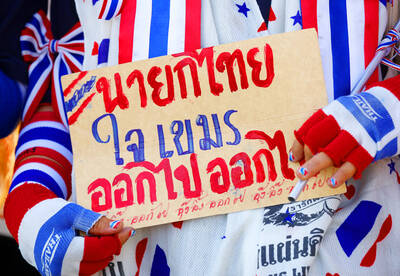Peru was in shock over allegations that a criminal gang killed people — perhaps as many as 60 — with the motive of rendering the fat from their bodies for sale to companies that make cosmetics.
Some experts have cast doubts on the horror story.
Human fat, once prized for cosmetics and medicinal uses, was collected in past centuries from the bodies of executed prisoners, a dark piece of history that may have inspired the gang.
Serapio Veramendi — one of the alleged members of the gang — made Peruvians shudder over the chance that it might be true.
“We used a wincha [tool] to cut off their heads. We hung the dismembered bodies from hooks, and then we lit up six or eight candles under them, and we waited for two or three days to have the fat drip into a bottle,” Veramendi, 32, reportedly told police.
Veteran police officers said this was the most macabre story they had ever come across.
The gang called themselves Los Pishtacos. In the mythology of Andean cultures, a pishtaco is a devil that kills people to steal their fat.
Peruvians were wondering just how far human beings are willing to go to satisfy their greed.
“How can there be people who dismember beings with the lone goal of getting money from human fat?” Peruvian Interior Minister Octavio Salazar wondered in shock.
Veramendi was arrested this week with three accomplices, after a routine police raid on buses traveling from the provinces to Lima found lemonade bottles filled with fat that later laboratory tests proved to be human. The bottles had been sent as packages to be delivered.
“It was sample material,” Veramendi said.
He said that the gang had already collected 17 liters of fat that they were hoping to sell to cosmetics firms — some of them allegedly in Europe — for US$15,000 per liter.
Indeed, authorities found such a supply of fat at the home of another alleged pishtaco, Elmer Castillejos, in a village in the central Peruvian province of Huanuco, about 400km northeast of Lima.
Seven suspects remain at large.
Even if some police doubt the story, criminal investigations director Eusebio Felix said authorities believed there were indeed some killings like the ones that Veramendi described.
Felix said, however, that it was not immediately possible to say how many people had been killed by the gang.
“You obviously cannot trust a criminal, but we have found sufficient evidence to be almost 100 percent sure that we are facing a case of pishtacos,” he said.
Police fear that the gang may have been active for years, perhaps as long as two decades, and do not rule out possible involvement in disappearances over the years of about 60 peasants in Huanuco and the neighboring province of Pasco, in the mountains, where the arrested suspects lived.
Still, Peruvian Medical Association dean Julio Castro Gomez remains unconvinced of the story.
He said that plastic surgery clinics obtain large amounts of fat in liposuction procedures and discard it because there is no market for it. Plastic surgery clinics sometimes do use fat to fill in wrinkles, but they extract the patient’s own fat from another part of the body for that purpose.
Besides, while Castro Gomez admitted that fat could be rendered out through makeshift procedures like the one that Veramendi described, he said that it would be full of impurities and thus useless.
Police were still working to determine what happened, particularly in the face of evidence that at least one victim — a 27-year-old man — was indeed killed and his body defiled in this way.

Eleven people, including a former minister, were arrested in Serbia on Friday over a train station disaster in which 16 people died. The concrete canopy of the newly renovated station in the northern city of Novi Sad collapsed on Nov. 1, 2024 in a disaster widely blamed on corruption and poor oversight. It sparked a wave of student-led protests and led to the resignation of then-Serbian prime minister Milos Vucevic and the fall of his government. The public prosecutor’s office in Novi Sad opened an investigation into the accident and deaths. In February, the public prosecutor’s office for organized crime opened another probe into

RISING RACISM: A Japanese group called on China to assure safety in the country, while the Chinese embassy in Tokyo urged action against a ‘surge in xenophobia’ A Japanese woman living in China was attacked and injured by a man in a subway station in Suzhou, China, Japanese media said, hours after two Chinese men were seriously injured in violence in Tokyo. The attacks on Thursday raised concern about xenophobic sentiment in China and Japan that have been blamed for assaults in both countries. It was the third attack involving Japanese living in China since last year. In the two previous cases in China, Chinese authorities have insisted they were isolated incidents. Japanese broadcaster NHK did not identify the woman injured in Suzhou by name, but, citing the Japanese

YELLOW SHIRTS: Many protesters were associated with pro-royalist groups that had previously supported the ouster of Paetongtarn’s father, Thaksin, in 2006 Protesters rallied on Saturday in the Thai capital to demand the resignation of court-suspended Thai Prime Minister Paetongtarn Shinawatra and in support of the armed forces following a violent border dispute with Cambodia that killed more than three dozen people and displaced more than 260,000. Gathered at Bangkok’s Victory Monument despite soaring temperatures, many sang patriotic songs and listened to speeches denouncing Paetongtarn and her father, former Thai prime minister Thaksin Shinawatra, and voiced their backing of the country’s army, which has always retained substantial power in the Southeast Asian country. Police said there were about 2,000 protesters by mid-afternoon, although

MOGAMI-CLASS FRIGATES: The deal is a ‘big step toward elevating national security cooperation with Australia, which is our special strategic partner,’ a Japanese official said Australia is to upgrade its navy with 11 Mogami-class frigates built by Japan’s Mitsubishi Heavy Industries, Australian Minister for Defence Richard Marles said yesterday. Billed as Japan’s biggest defense export deal since World War II, Australia is to pay US$6 billion over the next 10 years to acquire the fleet of stealth frigates. Australia is in the midst of a major military restructure, bolstering its navy with long-range firepower in an effort to deter China. It is striving to expand its fleet of major warships from 11 to 26 over the next decade. “This is clearly the biggest defense-industry agreement that has ever